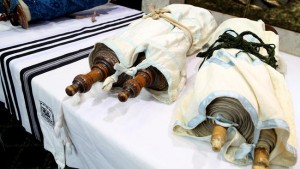
We often mistranslate teshuva as repentance, but that is not exactly accurate. The Alter Rebbe, R’ Schneur Zalman of Liadi explains that teshuva is not reserved for sinners. The root of the word teshuva is lashuv, to return. Teshuva is about returning our souls to the pure, pristine state in which we receieved them. Even the righteous need to go back to their roots and return home.
This Sunday, the seventh of the Ten Days of Teshuva, BRS will have the incredible privelege of returning precious stolen items to their roots, bringing them home to the Jewish people, and beginning the process of restoring them to their pure and pristine state.
Under the Nazi regime, thousands of Jewish communities and synagogues were ransacked and their valuables stolen. Sifrei Torah, Judaica, candelabras, kiddush cups, artwork, gold, and other valuables that were transported from the communities from which they were seized were collected in storage depots in Germany. In 1944, as the war was winding down, the Nazis expedited their deportation of the Hungarian Jewish community to death camps and simultaneosly stole their Judaica and treasures.
By early 1945, the Americans, British, and Russians were all advancing on Berlin. As depicted in the film “The Monuments Men” the U.S. and British Forces had special units that searched for stolen assets and sought to return them. The Russians, however, had what were referred to as “Trophy Units” that would seek out, seize and return to Mother Russia whatever valuables they could find.
Towards the end of the war, the Nazis were moving the stolen items from the Hungarian Jews on transports that were headed to Berlin. However, in the face of the advancing Russian troops they fled and left the train. Russian generals captured the train and took it from Germany to Russia.
Once in Russia, the train was taken to Nizhny Novgorod – which was then called Gorky – and which is 258 miles east of Moscow. Why there? Nizhny Novgorod was a “closed city” – meaing it was a military city and was carefully guarded (no one got into or out of the city without express permission). Once in Nizhny Novgorod, the train was unloaded. Over 1,000 Impressonist masterpieces were offloaded and stored in the Art Museum warehouses. Torahs were stored in the Library warehouse. There they sat for more than 40 years.
For decades after the War, Jewish communities in Eastern Europe living in countries that were part of the Soviet Union or satellite countries, such as Hungary and Czech Republic, tried without success to recover items that were stolen by the Nazis and taken to Russia. The stories of the Jewish treasures stored in Nizhny Novgorod were known but no one was ever permitted to get into Nizhny Novgorod’s Art Museum or Library to see what was really there.
In 2012, our own congregants Bob a”h Silver and his wife Sibyl first heard of the possibility of stolen Torahs in Russia. They were intrigued by the story, did research, and decided to dedicate themselves to retreive these Torahs and bring them back to the Jewish people.
They proceeded to inquire of Holocaust experts and made contact with rabbis in Hungary, Czech Republic, Austria, Germany, Belgium, Russia, and Cyprus to learn more. In the fall of 2012, on a visit to Prague, they learned more about the Torahs from the Chabad Rabbi in Prague who put them in touch with a young Chabad Rabbi in Hungary.
A year later, that rabbi, working together with the Chabad rabbi of Nizhny Novgorod, received permission to enter the Library in Nizhny Novgorod where he found the Torahs. He lovingly embraced them, examined, them and confirmed the rumors of their existence.
After Bob’s passing, Sibyl remained determined to rescue the Torahs. Earlier this year, Sibyl led a group to Russia in an attempt to get some of the Torahs back into synagogue use. She met with officials in Moscow and Nizhny Novgorod. Through her tenacity, perseverance, and passion for this project, Sibyl was able to get two Torahs into the Aron of the Chabad Synagogue in Moscow and eight Torahs into the Chabad Synagogue in Nizhny Novgorod where they are being repaired.
Not only have these Torahs not been in use for over seventy-five years, they haven’t been in the possesion of the Jewish people. These story of these Torahs is the story of the Jewish people. Like the many of the members of the communities from which they were taken, these Torahs were ripped from the hands of those who loved them, they were held hostage, put into captivity with no hope of being released or returned. And yet, like other members of the Jewish community from Eastern Europe, they have not only survived, but are being returned to their glory.
There were a total of 118 Torahs in the library warehouse. Ten are in the hands of the Jewish communities in Russia and Hungary, and this Sunday at 10:00 am we will welcome three of them into the Aron Kodesh at Boca Raton Syangogue. This will be their first time back in an Aron in over seventy-five years. Following the celebratory welcome back to the Jewish people at our shul, these Torahs will be restored and will ultimately find a permanent home and return to full use.
I had the privelege of examining these Torahs and it sent a current through my spine. When you come in contact with these sacred scrolls, you are in contact with the the souls of the 6 million martyrs and with the story of our people.
This article originally appeared on Rabbi Goldberg’s blog.
The words of this author reflect his/her own opinions and do not necessarily represent the official position of the Orthodox Union.

